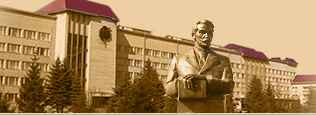THE HISTORICAL ASPECTS AND PROBLEMS OF SOIL COVER STRUCTURE.
The historical analysis of the theory of the soil cover structure in domestic and foreign scientific schools was provided. The general theoretical framework to study the soil cover structure in the fundamental works of Friedland V.M., Hodelman J.M., Tarhulyan V.О., Duchaufour Phillip, Peter Fink, Legros, J-P., Pozniak S.P., Radziy V.F., Haskevych O.V. and others have been analyzed. The evolution of the concept of the smallest unit of soil cover structure (elementary soil area, polipedon, pedotop) was described. The microkaten concept, based on genetic and evolutionary theory presented and determined as directed anisotropic soil-geographic unit. Microkatena is nothing but a chain of soils belonging to two or more units of classification and gradually passing one another. Inspite microkateny, the elementary soil unit is represented by soil individuals that affect only one taxonomic unit on the lowest rank. The need to use remote sensing data to study the soil cover structure was shown. Such data may include information about map generalization, the boundaries of specific soil combinations, composition of the soil cover. The article mentioned that the aerial photos and satellite images are large-scale information on the availability, distribution, warehouse of the elementary soil structures (complexes, spots) and lithological-geomorphological characteristics of the area. The methodological issues that may arise when using remote sensing data were described. Attention is paid to the concept of elementary soil unit.
Keywords: soil cover structure, elementary soil unit, soil association, polipedon, remote sensing data.
References:
- Haskevych O. V. Struktura hruntovoho pokryvu Holohoro-Kremenetskoho horbohiria: monohrafiia / O. V. Haskevych, S. P. Pozniak. – Lviv: LNU im. I. Franka, 2007. – 208 c.
- Hodelman Ya. M. Neodnorodnost pochvennoho pokrova y yspolzovanye zemel / Ya. M. Hodelman. – M.: Nauka, 1981. – 200 s.
- Hryhorev H. Y. Neodnorodnost pochvennoho pokrova y ee vydy v podzolystoi zone / H. Y. Hryhorev // Pochvovedenye. – 1970. – #5. – C. 3-11.
- Dymo N. A. V oblasty polupustyny: pochvennye y botanycheskye yssledovanyia na yuhe Tsarytsynskoho uezda Saratovskoi hubernyy / N. A. Dymo, B. A. Keller. – Saratov: Saratovskoe hubernskoe zemstvo, 1907. – 215 s.
- Evald E. Nekotorye novye podkhody k systematyke pochv HDR / E. Evald. // Pochvovedenye. – 1967.
- Kryvulchenko A.I. Obgruntuvannia do systematyky landshaftnykh kompleksiv Prychornomorskoho sukhoho stepu / A.I. Kryvulchenko // Ukr.. heohr.. zhurn. – 2002. – #4. – S. 10-16.
- Markyna S.Y. SPP y kachestvennaia otsenka terytoryy stepnykh y lesostepnykh rehyonov Dnestrovsko-Prutskoho mezhdurechia / S.Y. Markyna. – Avtoreferat #4 uch.st. k.h.n. Odesa, 1986. – 21 s.
- Neustruev S. S. Elementy heohrafyy pochv / S. S. Neustruev. – Moskva: Selkhozghyz, 1930. – 240 s.
- Pozniak S.P. Kartohrafuvannia gruntovoho pokryvu: Navchalnyi posibnyk. / S.P. Pozniak, Ye.N. Krasiekha, M.H. Kit. – Lviv: LNU im.I.Franka, 2003 – 235 s.
- Radzii V. F. Struktura gruntovoho pokryvu Volynskoi vysochyny: monohrafiia / V.F. Radzii, S. P. Pozniak. – Lutsk: VNU im. Lesi Ukrainky, RVV “Vezha”, 2009. – 204 s.
- Sybyrtsev N.M. Yzbrannye sochynenyia / pod red. y s predysl. S.S. Soboleva – M. : Selkhozghyz. – T. 1 : Pochvovedenye. – 1951. – 472 s.
- Frydland V.M. Struktura pochvennoho pokrova. / V.M. Frydland. – M., „Mysl”, 1976. – 140 s.
- Frydland V.M. Struktura pochvennoho pokrova myra / V.M. Frydland. – M., „Mysl”, 1984. – 205 s.
- Boulaine, J. Early Soil Science and Trends in the Early Literature.In P. McDonald (ed). The Literature of Soil Science. pp 20-42. Cornell University Press, Ithaca, NY.
- Buol, S. W. Soil genesis and classification / W. Buol, F.D. Hole, R. J. McCracken & R. J. Sothard. – Fourth ed. Iowa State Univ. Press Ames. – 1997.
- Bushnell T. M. Some aspects of the soil catena concept / – Michigan: Ann Arbor, 1942. – 476 p.
- Dobos E. A regional scale soil mapping approach using integrated AVHRR and DEM data / Dobos E., L. Montanarella, T. Negre, Micheli E. – International Journal of Applied Earth Observations and Geoinformation. Vol 3 Issue 2001.
- Duchaufour, P. Pedology: soil, vegetation and environment / Phillip Duchaufour. – Abreges, France, – 289 p.
- Hole, F. & Campbell J.B. Soil Landscape Analysis / Hole. – RKP, England, 1985.
- Jenny, Hans. The image of soil in landscape art, old and new. Pontifical Academy of Sciences / Jenny. – Scripta Varia 32: 1968. – pp 947–979.
- Johnson W.M. The pedon and the polypedon / M. Johnson // Soil Sci. Soc. Amer. Proc. – 1938. – Vol.3. – №2. – P. 212-215.
- Legros, J-P. Mapping of the Soil/ Jean-Paul Legros. – Science Publisher, USA., 2006. – 411 p.
- Milne, G. Some suggested units of classification and mapping particulariu for East African soils / Milne // Soil Res. – 1935. Vol. 4. – №3.
- Minasny Resolving the integral connection between pedogenesis and landscape evolution / Budiman Minasny,Peter Finke, Uta Stockmann, Tom Vanwalleghem and Alex McBratney. – Earth-Science Reviews. – 2015. – p.102-120
- Simonson R. W., Gardner D. R. Concept and function of the pedon / W. Simonson // Trans. 7 th Intern. Congr. Soil Sci. (Madison). – 1960. – Vol. 4 + Vol. 18. – P. 127-131.
